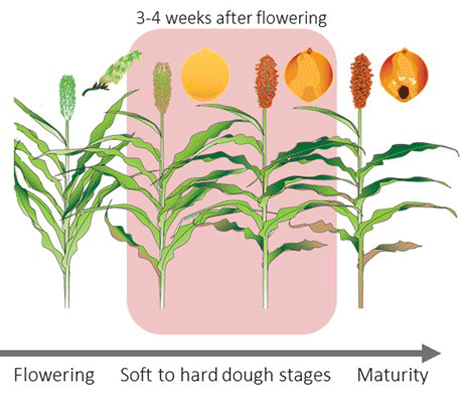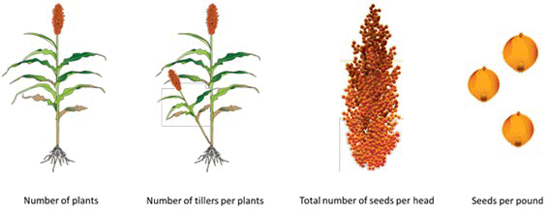The time when farmers can start estimating sorghum yields is upon us. In the most recent USDA-NASS Kansas Crop Progress and Condition report (Sept. 8), sorghum in Kansas was 96% headed, 63% coloring, and 23% mature, which were all near or ahead of average. Even though estimating crop yields before harvest can be difficult, having these estimates is valuable information for producers, as it helps them to make relevant decisions on inputs.
When can I start making sorghum yield estimates?

Figure 1. Sorghum flowering stages. Image credit: K-State Research and Extension.
As the sorghum crop gets closer to maturity, yield estimates will be more accurate. Nonetheless, we can start taking yield estimations three to four weeks after flowering (from soft to hard dough stages), though final seed number can change. In addition to the seed number, the seed weight will be only partially determined – approximately 50 to 75% of dry mass accumulation as compared to the final weight attained at maturity.
Understanding sorghum yield components and management/environmental impacts
- Plants per acre, planting date: These affect the plant's ability to tiller. The more plants per acre, the less tillering. Earlier (mid-to-late May) planted sorghum tends to tiller more compared to later (mid-to-late June).
- Environment, final head number, and size: Heat and drought stress will reduce the plant’s ability to tiller more and could severely reduce the tiller survival rate. The total number of seeds per head will be determined within a 1 to 2-week period before flowering until the milk to soft dough stages (approximately two to three weeks after flowering).
- End-of-season seed size: Sorghum grains have already accumulated about 50% of the final dry mass during the soft dough stage (15-25 days post-flower). Thus, the period around flowering is critical for defining the final number of grains per head and the potential maximum kernel size. The final seed weight will be determined when the grains reach physiological maturity (visualized as a “black layer” near the seed base). From this time until harvest, the grains will dry down from approximately 35% to 20% moisture content.

Figure 2. The four main components of sorghum yield are the number of plants, tillers, seeds per head, and seed size. Graphic by Ana P. Carcedo, K-State Research and Extension.
Variability within the field
The interaction among all four components will determine the final yield, but a wide range of variation can be expected in all these main yield-driving forces. When estimating sorghum yields using the “on-farm approach”, the variability between plants needs to be properly accounted for. Another important factor is the variation between different areas in the field, with yield estimations being conducted in at least 5 to 10 sections of the field.
On-farm approach for estimating sorghum yields
The sorghum yield estimates should consider these main driving forces:
- Total number of heads per unit area [number of plants per acre x heads per plant]
- Total number of seeds per head
- Number of seeds per pound
- Pounds per bushel, or test weight, which for sorghum is 56 lbs/bushel
Step 1. Number of heads per unit area
For this on-farm approach, start by counting the number of heads from a 17.4-foot length of row when the sorghum is in 30-inch row spacing (this represents 1/1000th the area of an acre). If the sorghum is in 15-inch row spacing, then count the number of heads in two rows. For a 7.5-inch spacing, take into account four rows.
Take head counts in several different field areas to properly account for the potential yield variability. If the proportion of smaller heads (less than 3 inches in height) is very low (< 5%), those heads could be avoided due to the smaller proportion for determining the final yield estimation.

Figure 3. Calculating the total number of heads per acre.
Step 2. Estimating the number of seeds per head
The seed number is, by far, one of the most complicated yield components to estimate. The total number of seeds per head can vary from 100 to 5,000 seeds per head, but most of the time the number is around 1,500 to 2,500 seeds per head.
The method of estimating seed counts is summarized in Table 1.
- If conditions were very poor during pollination and grain set, and the general yield environment is low, the total number of seeds per head will average around 900 seeds per head.
- If conditions around flowering were very favorable and the general yield environment was very high, then the number of seeds per head could be around 2,500.
- Intermediate yield environment scenarios can occur if a portion of the 3 to 4-week period around flowering was favorable and part of it was unfavorable. In that case, the number of seeds per head could average around 1,745.
This information is provided only for general guidance on estimating sorghum yield potential using the on-farm approach.
Table 1. Total number of seeds per head and seed weight components.
|
Yield range (bu/acre) |
Crop condition |
Average seeds per head |
Average seed weight (g/1000) |
Number of observations |
|
<50 |
Very poor |
900 |
24.5 |
154 |
|
50-100 |
Poor |
1500 |
25.5 |
391 |
|
100-150 |
Fair |
2000 |
26.2 |
495 |
|
150-200 |
Good |
2500 |
25.6 |
129 |
|
>200 |
Excellent |
3330 |
25.5 |
5 |
Step 3. Estimating seed weight
A similar procedure can be followed to estimate the seed weight (Table 1). For the seed weight component, there is a very narrow variation compared to the variability in the seed number. Generally, lower seed weight is expected with low yield, but the difference among yield levels is negligible. Table 2 shows the conversion from average seed weight to seeds per pound.
Table 2. Seed weight, seeds per pound.
|
Yield range (bu/acre) |
Crop condition |
Average Seed weight (g/1000) |
Seeds per pound |
|
<50 |
Very poor |
24.5 |
18520 |
|
50-100 |
Poor |
25.5 |
17793 |
|
100-150 |
Fair |
26.2 |
17318 |
|
150-200 |
Good |
25.6 |
17723 |
|
>200 |
Excellent |
25.5 |
17793 |
Step 4. Final calculation using the “On-Farm” Yield Estimation Approach:

Example calculation for dryland sorghum in Kansas
Dryland sorghum with 72,000 heads/acre), fair flowering (2000 seeds/head), and good grain filling (17,723 seeds/pound):
Yield Estimation = [(72,000 x 2,000) ÷ 17,723] ÷ 56 = 145 bu/acre
Logan Simon, Southwest Area Agronomist
lsimon@ksu.edu
Tina Sullivan, Northeast Area Agronomist
tsullivan@ksu.edu
Lucas Haag, Agronomist-in-Charge at Tribune
lhaag@ksu.edu
Tags: grain sorghum sorghum yield estimates yield components